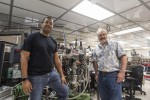In 2006, a NASA-owned rocket landed on Earth after a seven-year journey beyond the orbit of Mars.
The rocket flew through the tail of a comet, collecting thousands of dust particles for NASA’s Stardust mission. After the Stardust landed, the UCLA Department of Earth, Planetary and Space Sciences requested particles from the mission to study with its IMS-1270 ion microprobe, one of about a dozen instruments of its kind in the world.
UCLA’s original IMS-1270 was the first large-format ion microprobe ever built, with a magnet large enough to analyze rock samples with high mass resolution and high sensitivity, said Kevin McKeegan, co-director of the Secondary Ion Mass Spectrometry laboratory, or SIMS lab for short. The lab received its second microprobe in December.
Both instruments contribute to research in solar system history on and off Earth, using mass spectrometry to date elements that can be millions or billions of years old, he said.
[Related: UCLA researchers use spacecraft to uncover details about solar system’s early formations]
McKeegan and Mark Harrison, another lab co-director, helped design and test the original probe prototype nearly 25 years ago with grants from the National Science Foundation. The old probe cost 2 million dollars to build, and the newer one cost 5 million.
“This device is an old friend that we’ve taken apart and put together many times,” McKeegan said, circling the old probe. “It’s normal when you’re building something new for the first time.”
Now, Christopher Snead, a ninth-year graduate student in earth, planetary and space sciences, is wrapping up his doctoral thesis using the Stardust mission’s comet dust after nearly 10 years of study.
Snead used the probe to count three oxygen isotopes in his samples: oxygen-16, -17 and -18. The ratios of oxygen isotopes in comets can tell researchers about chemical and environmental conditions of the early solar system, Snead said.
Competing models suggest that these ratios originate from supernovas, photochemical reactions or oxygen evolution.
“Maybe (isotopic ratios) show a galactic evolution of oxygen,” Snead said. “My research is to find out whether these results from comet dust are consistent with some models versus others.”
The tiny Stardust mission particles can be less than 20 microns wide, smaller than the diameter of a human hair, McKeegan said. The Stardust rocket captured them in flight using aluminum foil and aerogel, one of the least dense solids in the world. After NASA approved Snead’s proposal for samples, the Johnson Space Center sent him pieces of foil with the dust embedded in craters within. Snead mounted them on 1-inch metal discs for insertion in the machine.
The hulking, U-shaped probe shoots beams of oxygen or cesium ions at the samples, causing them to eject charged secondary ions, Snead said. Magnets in the probe separate these secondary ions by mass using a method called mass spectrometry, similar to the way a prism separates light into the colors of a rainbow. Finally, Snead used three ion counters – one for each oxygen isotope – to quantify the isotopic ratios present in the material.
Last week, McKeegan gave a public lecture about chondritic meteorites in the UCLA Meteorite Gallery, discussing how the space rocks, with their inclusions of calcium and aluminum, are some of the oldest dateable rocks in our solar system. People from all over the world have requested time at the SIMS lab to analyze the compositions of meteorites, rocks, minerals and otoliths – calcium carbonate stones from a salmon’s ear – McKeegan added.
“We’ve studied the migration patterns of fish,” he said. “It’s something completely different from the geology that we normally do. Colleagues from Northern California and Canada are looking at salmon populations. … (Otoliths) trace where the fish have been feeding.”
UCLA researchers can also use the probes’ dating capabilities to dig into the origins of life. Crystals from early Earth formation act as little time capsules, McKeegan said.
“We know life started somewhere, but knowing exactly when and knowing exactly how is another little problem,” he added.
[Related: UCLA welcomes new course on the search for extraterrestrial life]
Last year, postdoctoral research scholar Elizabeth Bell published possible evidence that a terrestrial biosphere had formed 300 million years earlier than previously believed. Bell’s team used the microprobe to analyze zircon from a 4.1-billion-year-old Australian sandstone, discovering carbon graphite in one sample.
“The chemical processes by living things yield very high ratios of carbon-12 to carbon-13 in biogenic carbon, as compared to inorganic carbon found elsewhere on Earth,” Bell said. “Since we found high ratios (in zircon)… one possible explanation is that its graphite was made of the remains of earlier living tissue.”
Researchers continually use the microprobes for geochronology studies. One current project is trying to date the formation of our planet’s moon, McKeegan said.
“I’ve done work on the chronology of the first couple million years before planets were forming,” he added. “You never know what’s going on around here.”
